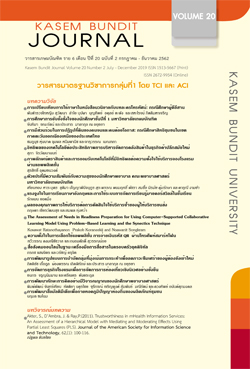Brand Image and Technology Acceptance Affecting Hotel Booking Intention via Application
Keywords:
Brand image, technology acceptance, intention to use, applicationAbstract
The main purposes of this study were to study the influence of brand image and technology acceptance on hotel reservation intention and to examine the causal model consisting of brand image, technology acceptance, satisfaction, and hotel reservation through application intention. This study used questionnaires for collecting data. The samples were 400 undergraduate students in Bangkok. Smart PLS 3.0 was the main statistical technique employed for data analysis. It was found that brand image and perceived ease of use influenced perceived usefulness significantly. The brand image, perceived ease of use and perceived usefulness affected satisfaction significantly. Moreover, satisfaction influenced on intention to use significantly.
References
Ajzen, I. (1991). “The theory of planned behavior”. Organizational Behavior and Human Decision Process, 50, 179-211.
Amaro, S., & Duarte, P. (2015). “An integrative model of consumers’ intentions to purchase travel Online,” Tourism Management, 46, 64–79.
Cao, C. & Chen, J. (2011). “An empirical analysis of the relationship among the service quality, customer satisfaction and loyalty of highspeed railway based on Structural Equation Model.” Canadian Social Science, 7(4): 67-73.
Chong, Y. L. (2013). “Understanding Mobile Commerce Continuance Intentions: An Empirical
Analysis of Chinese Consumers.” The Journal of Computer Information Systems, 53(4), 22-30.
Comrey, A. (1973), A First Course on Factor Analysis, Academic Press, London.
Comrey, A. L., & Lee, H. B. (1992). A First Course in Factor Analysis (2nd ed.). New Jersey: Lawrence Erlbaum Associates. Retrived October 15, 2009, from https:// www.ingentaconnect.com/content/apl/lcbi
Davis, F.D. (1989). “Perceived usefulness, perceives ease of use, and user acceptance of information technology.” MIS Quarterly, 19-40.
Digital Advertising Association Thailand. (2561). Digital Advertising Spend 2016-2017. Retrieved on September 20, 2018, from https://www.daat.in.th/index.php/digital-advertising2017 (in Thai)
Hsieh, M. H., Pan, S. L., & Setiono, R. (2004). “Product-, corporate-, and country-image dimensions and purchase behavior: A multicountry analysis.” Journal of the Academy of Marketing Science, 32(3), 251-270.
Wisner, Joel D. and Stanley, Linda L. (2007). Process Management: Creating Value Along the Supply Chain. USA: Thomson south-western.
Johanudin, L. (2016). “A Study of Brand Image towards Customer’s Satisfaction in the Malaysian HotelIndustry.” Social and Behavioral Sciences, 224, 149 – 157.
Kasikornbank. (2561) The competition of Hotel. Retrieved on September 20, 2018, from
https://www.kasikornbank.com/th/business/sme/KSMEKnowledge/article/KSMEAnaly Pages/Com petitive-Hotel-Industry.aspx.
Ketikidis, P. (2011). Acceptance of Health Information Technology in HealtProfessionals: An Application of the Revised Technology Acceptance Model. Proceedings of the 15th International Symposium on Health Information Management Research – ISHIMR 2011
Kline, R. B. (2010). Principles and practice of structural equation modeling(3rd ed). New York, NY: The Guilford Press.
National Statistical office. (2559). Indicator of tourism Status. Retrieved on September 20, 2018, from https://www2.bot.or.th/statistics/ReportPage.aspx? reportID=624& langu age=th.
See, S.S., Khalil, M.N., & Ameen, M.A. (2012). Factors affecting Malaysian young consumers’ online purchase intention in social media websites. Procedia-Social and Behavioral Sciences, 40(2012), 326-333.
Vroom, W.H. (1964). Working and Motivation. New York: John Wiley & Sons
Downloads
Published
How to Cite
Issue
Section
License
ทัศนคติ ความคิดเห็นใด ๆ ที่ปรากฏในวารสารเกษมบัณฑิตฉบับนี้เป็นของผู้เขียน โดยเฉพาะ มหาวิทยาลัยเกษมบัณฑิตและบรรณาธิการ ไม่จำเป็นต้องมีความเห็นพ้องด้วย







